Getting There
Travel to Patagonia from almost anywhere is complex. Arrival from the US will generally involve at least one flight to northern Chile or Argentina, and then another to a major Patagonian travel hub such as Punta Arenas, and then a third leg by bus to a smaller gateway town. The biggest difference between Torres del Paine and Fitz Roy is that the gateway town for Torres — Puerto Natales — is yet another two hours by bus from the park.

Our chosen route, and probably the most common route, was to fly from the US (we went through DFW) to Santiago, Chile. At nine and a half hours, this was the longest plane ride of our lives, far surpassing those to Maui, Lima, Paris and other far flung destinations.
From Santiago, one next flies to the seaport city of Punta Arenas, over a thousand miles to the south on the Strait of Magellan. This is an additional three hours. From Punta Arenas, where one MAY be re-united with ones baggage, there is a three hour long (relatively straightforward and comfortable) bus ride to Puerto Natales. We took a rest/recovery day in Puerto Natales, but it certainly is possible to continue straight on to the park by bus.
It may be more practical to fly directly into Puerto Natales, which has a small, recently modernized airport with a new runway that can accommodate modern jetliners. Sylvia and Brian were unable to find any reasonably priced flights this small airport when we traveled, but a search of Expedia by Brian before writing this revealed that, yes, there are SOME flights available in January, but not every day of the week; and these were no more unreasonably priced than those to Punta Arenas.
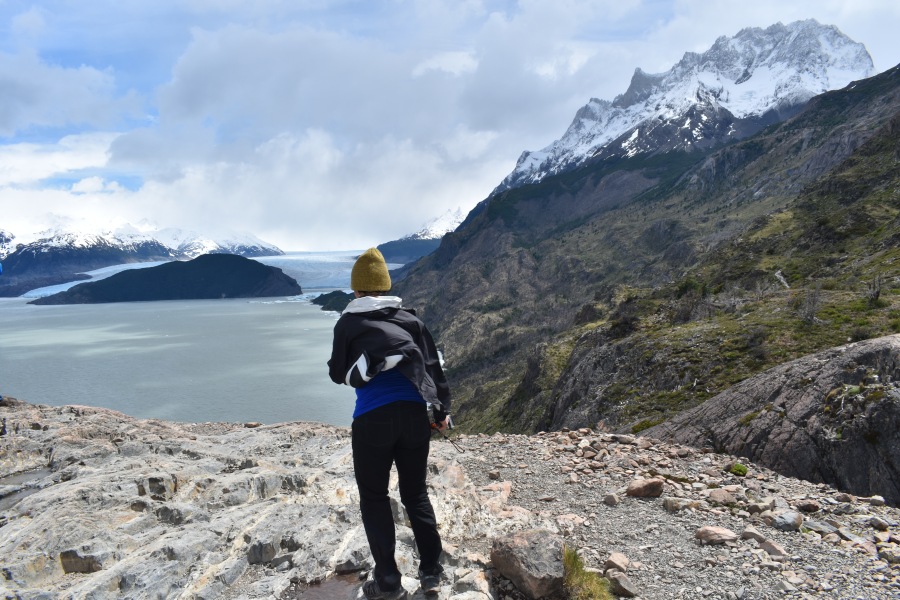
Our understanding of the situation at the Puerto Natales airport, Julio Gallardo, is that no scheduled commercial flights came through it at all for a period of many years, and that service has only recently resumed, and may still be sketchy. We talked to one man who had intended to fly into this airport from Portland, Oregon, via Lima, Peru; and his was a tale of woe and misery; cancelled flights, hours stranded in foreign airports, lost luggage.
Our advice is to check the availability of flights and consider flying into Puerto Natales directly if you get a good deal. But until further notice, we still think the bus route from Punta Arenas should be considered the primary option. Buses to these locations run quite often, in some cases hourly.
If one is coming in via Argentina, it’s a similar route except that one would fly to Buenos Aires instead of Santiago, and from there fly to El Calafate instead of Punta Arenas. From El Calafate it is a bus ride of some three hours, again fairly comfortable and straightforward, to El Chalten. There is no commercial airport in or near El Chaltèn as of this writing.
Doing Torres and Fitz Roy Both
Many people come for Torres del Paine, but opt to see Fitz Roy as well, since the two parks are relatively close. That’s exactly what we did.

This is entirely doable, although the two parks are not in reality as close as it looks on the map. (“Close” in Patagonian terms means…it’s not TOO far over the horizon.) Puerto Natales and El Chalten are separated by two moderately long bus rides, about half a day’s worth of travel.
We would advise any travelers to consider this two-for-one option, as it is a chance to see two wonders of the natural world in what might be a once in a lifetime trip. However, do be aware that crossing by bus from Chile to Argentina by bus (and the reverse of the return) may involve lengthy delays at very remote and understaffed border crossings.
Chile and Argentina are NOT the European Union, nor is this the US/Canadian border; paper work is checked and passports stamped just like any point of entry. And none of it happens in a hurry.
You will be stopped twice, once to be processed out of the country you are leaving (which is typically a short delay) and once again to be processed on arrival at the new country. The second delay can involve searches of the bus, searches of luggage, metal detectors, etc. In peak season, this could be a very lengthy processes; we’re talking hours.
Our processing from Chile to Argentina added at least another 90 minutes to the trip; on the way back, it was even longer, and this caused us to miss a bus connection.

Planning for Torres del Paine
The first thing to get straight is…forget winging it in Torres. Anyone who shows up here armed merely with boots, tent and backpack, but without a plan, is likely to be disappointed. At best you will end up with some half-assed itinerary based on last-minute cancellations. At worst, you will be sent packing without hiking at all.
To hike the W or O circuits requires planning and advanced reservations, plus an understanding of the rules, regulations and special requirements of Torres del Paine National Park. You may or may not find the online resources provided by the park helpful (with a strong lean toward ‘ may not.’) Fortunately, there exist no shortage of other online resources, including this one.
In order to build an itinerary for the W, you should begin planning a minimum of six months out, preferably more. Start by asking yourself a few simple questions. How long am I prepared to devote to this trip? What am I able to spend? How much of a physical challenge am I able to handle?
Once you have the answers to those basic questions, it will help you to answer the more specific questions below which must be addressed to develop a trip plan.
Full Circuit or W?
First decide if you want to do the W or Full Circuit (The “O”.) If you chose to do the full circuit, this route will allow you very little flexibility; you must proceed in one direction, you must book ALL campsites or lodges in advance, and you MUST bring a tent and all necessary gear.
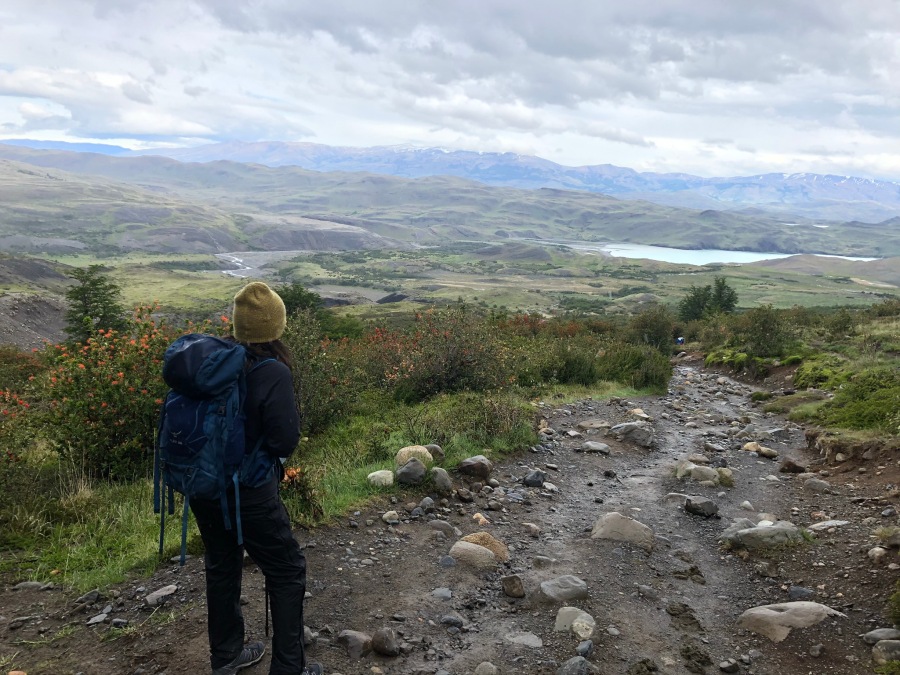
Start East or West?
If the W is more your thing, you have more choices. Decide which way you want to do it…west to east (what we did) or east to west. Note that for either, the catamaran to Pudeto is an essential cog in the trek, either at the beginning or end. It runs infrequently and cannot be reserved.
Primary direction decides your start point…Paine Grande or Torres Central. With that out of the way, it’s time to start thinking about HOW you will hike.
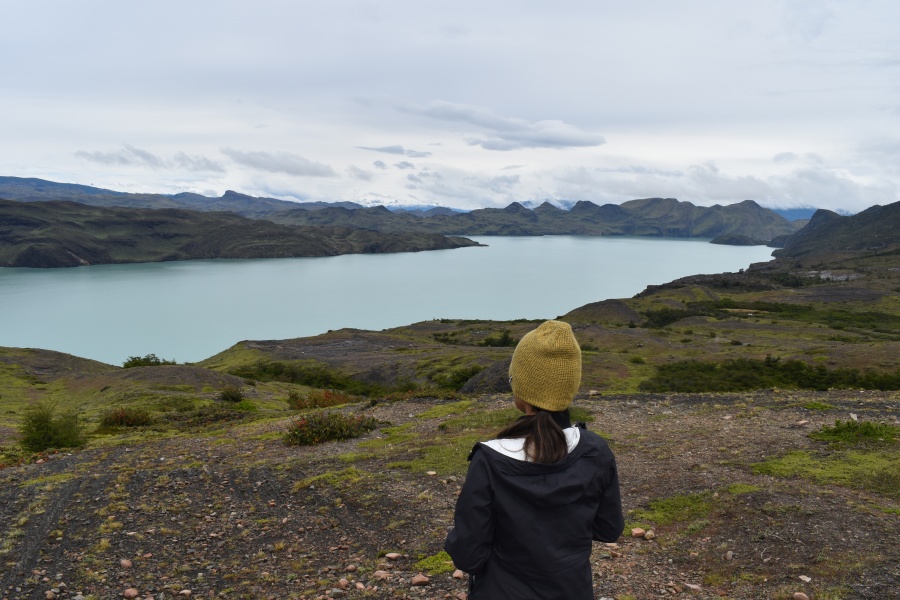
Full Backpack, Slackpack, or Day Pack?
The easiest (from a booking point of view) most authentic and cheapest way to hike the W is to tent the whole way, carrying all of your required gear. (Note that if you do the O, you have no choice but to camp at least some nights.) You will be responsible for securing your gear against the oft ferocious Patagonian winds, and you will prepare all your meals and provide your own stove and fuel. (Note that resupply in the park is possible, but expensive.)
This option is recommended to fit, strong, self-sufficient hikers who can carry a heavy pack across rough terrain for several days. It is also the best option if you have a tight budget. Most of the people we saw going it the rough way were young, military/college age men and women, the stereotypical ‘broke backpackers.’
However, for most anyone else (those of a ‘certain age’, those who have ‘trick knees’ or creaky backs or ‘crankles’, those who aren’t necessarily in the best conditioned shapes of their lives) we would urge strongly considering all possible alternatives to decrease pack weight and increase enjoyment.
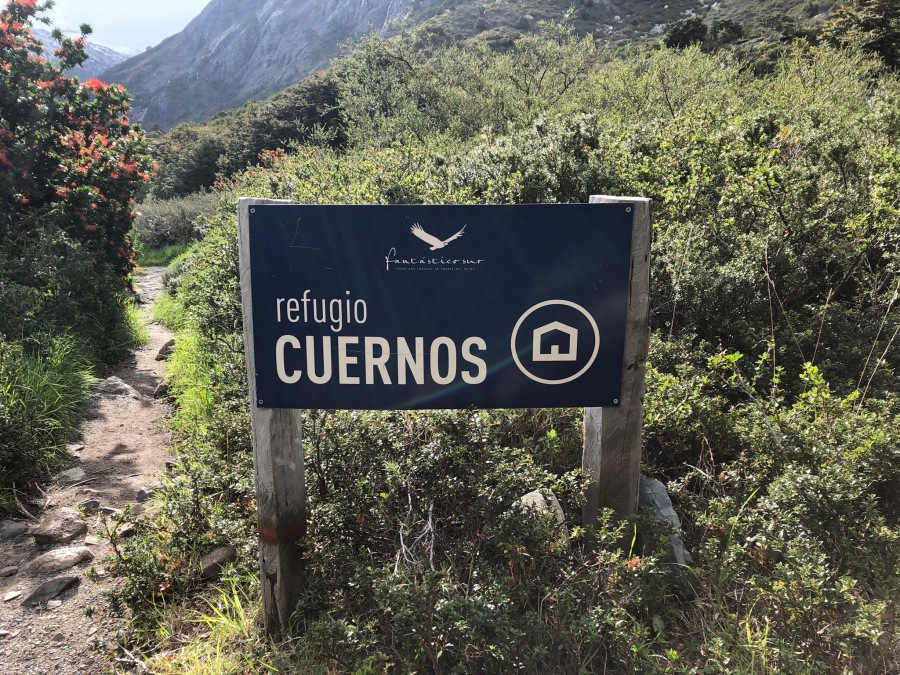
Understand that while the individual sections of the W are often referred to as ‘moderate’ or ‘easy’ by many sources, we did not find most of them to be either. The W has many difficult sections, quite a few of which must be traversed with full pack; and one must also take into account the cumulative effect that five days of hiking with a heavy pack must inevitably have on your body regardless of the character of the trail.
Brian carried a pack weighing at least thirty pounds, much more than his 2018 Tour du Mont Blanc pack weight, and found the experience to be very tiring. He also believes that having to perform camp chores on tired legs at the end of a hard day can often do as much damage to joints as the hiking does. Despite the sense of accomplishment, the heavy pack definitely limited his enjoyment of the experience.
Consider each of the following as methods of “increasing enjoyment”:
- Carry a tent and all other gear but book meals in refuges and leave the stove at home. We did this. Saves some weight and some camp chores; adds some expense. Should be booked in advance.
- Rent critical gear such as your tent, which will be set up for you at each stop by the refuge/campground personnel. Saves even more weight and most of the camp chores, and ensures your tent will be secured properly (we observed that the rented tents are robust North Face and Mountain Hardware expedition grade models, securely tied down.) Much more expensive and needs to be booked well in advance.
- Stay at Refugios. Ensures a day-pack weight and saves all camp chores, but is VERY expensive and must be booked VERY far in advance, maybe years.
Had we to do it over, we would definitely consider renting gear. Note that if you do opt for any of the slackpacking ways, no meals, gear rentals or lodging is available in the primitive Campo Italiano.
What Season?
Decide what season you want to go. Summer (January/February) has the best chance of clear weather but will be very crowded and bookings may be difficult. Spring and fall may be better options. Brian and Sylvia hiked very close to the start of the regular season, which usually begins around November 15. We had generally good weather for most of the hike (one bad day out of five) and the notorious winds were mostly mild.

Note that availability of bookings may determine when you may be able to visit. It is now almost impossible to hike this Trek without everything booked in advance.
How many days?
We strongly recommend five days, minimum, to do this trek. It can be done in four by a strong hiker, but we don’t recommend it. Even those who can do so should not rush this trek if it can be avoided.
Note that it will be VERY difficult nowadays to show up at the park, get off the bus and start hiking. You will be hard pressed to make the cutoff times. One really needs to arrive at the park the day before hiking.
In addition, it would be prudent to build in an extra day at the end just in case you are washed out at the Towers and need a re-do. (Happened to us, but we alas had no time for a re-do.) An extra day in this park will NOT be wasted, trust us. So our advice, ultimately, is to spend a full week in the park assuming you can devote that much time.
Don’t’ Forget the Evac Plan
If your itinerary ends at Paine Grande, don’t forget that you need to hop the catamaran back to Pudeto, especially if your plan is to take the bus back to Puerto Natales. Know what the schedule will be in advance so you don’t miss the last boat and have payment ready when you board.

Planning for Fitz Roy
Compared to Torres, planning for Los Glaciares National Park of Argentina is easier in just about every way possible. There is no entrance fee, few rules and regulations that interfere with hiking, and no advanced bookings that are absolutely required. Most hikes can be done right out of El Chaltèn, and most people find the Argentinian National Park staff to be far more organized and helpful than their Chilean counterparts.

Here, it is entirely possible to simply arrive with a pair of boots, a sack full of gear and no plan at all, and simply start hiking. Heck, that’s pretty much what we did. Our only warning is that El Chaltèn is starting to become much more popular as an alternative to the crowded and frustratingly bureaucratic Torres del Paine; we found bookings in this little town to be much harder to come by than we figured at a surprisingly early point in the season.
You will have many more options here. But it is still worth asking yourself the same questions you asked in Torres – how many days, how much money, and how much effort am I willing to spend here?
To Tent or Not to Tent
Once here, Fitz Roy really is as simple as it sounds. You get off the bus and you hike where you please when you please. All you need is a base of operations.
The key question is whether or not to even bring a tent. Most people simply stay in town and day hike the park, either directly from their hotels/hostels or using a shuttle. The advantages of doing this are many and obvious, not the least of which is the ability to hike with a light pack.

Hiking Fitz Roy is very weather dependent. When it is bad it can be VERY bad, and you won’t get any views of the things you really want to see. Day hiking the park out of El Chaltèn gives the hiker the flexibility to strike when the weather is calm and clear (or at least one of the two) and go to ground on those days when it is not.
There is however a case for tenting, apart from the purely esoteric benefits of doing this park the ‘right’ way. For one thing, while staying in El Chaltèn is not terribly expensive, it certainly is not free. Tenting on the other hand is free and requires no special permit or reservation. It’s pretty simple as long as one follows the rules.
The second argument is crowds. Though Fitz Roy is much less crowded than Torres Del Paine in general, the more celebrated hikes near town, because of their easy accessibility, will be even more crowded. And when the weather clears, EVERYONE heads to the trail. Do not count on an early start helping you…the commercial tour groups already know how things work. We found the Laguna de los Tres hike to be so crowded it really detracted from the experience. The only reliable way to avoid the crowds would be to camp near the big ticket views and have them mostly to yourself early and late, before the masses arrive or after they leave.
The third factor that argues for tenting is the that the big peaks, Cerro Fitz Roy and Cerro Torre, can stay behind the clouds for days at a time…even on days when the sky is mostly clear. Our experience in the short time we were there was the peaks were more apt to clear in the late afternoon. By camping you give yourself two windows – in late afternoon and again in the morning – in which to get lucky with the weather. Morning is also by far the best time for photographing the peaks bathed in alpenglow.

With all that said, we still feel the benefits of staying in town outweigh those of tenting. Brian and Sylvia hiked directly out of town (we had a tent with us too, technically speaking, but we did not use it) and have no regrets about it…in fact we LOVED the experience that is El Chaltèn.
If you are planning to stay in town, El Chaltèn is quite small so it does not really matter what part of it you stay in…every building is a ten-minute walk or less from every other. We do recommend that that you do not take it for granted that you will be able to book a room here. Book well in advance to find the best options and deals or else you may get shut out.
How Many Days?
We cannot emphasize enough that the key to hiking this park is clear weather. The more days you have to work with the better your chances of being able to do more than one hike, so our advice is to spend as many as you can here. Three is probably minimum; five is better. Study the forecast; try to save the BEST day for Laguna del los Tres. But if you get two or three good days in a row, well, yell “jackpot!” and start hiking as many trails as you can. On those days where there are no views, go to ground, sample the great local food, or do a lower-key, less weather dependent walk.
We loved the experience of El Chaltèn
When to go?
Weather in the El Chaltèn area is less dependent on regional climatic factors and far more dependent on local ones, namely the huge nearby glaciers. It is much more volatile and hard to predict than Torres del Paine, which is saying a great deal. There is no dry season, the wind can blow anytime, and the big peaks tend to collect clouds even out of seemingly clear blue skies.
There is no season that guarantees good weather or better visibility. However, November is probably the dy-EST month of the year, and when we visited, around US Thanksgiving, the temperatures were ideal for hiking and the winds surprisingly calm. We had two days of good clear weather in five. That’s actually a pretty good average for this part of the world.
We can only say we had a good experience in November, but we hesitate to recommend this or any time of year as the ideal one to visit Fitz Roy. To be clear: Good days in this park are uncommon, any time of year. The best way to maximize your chances of having a good experience here — as outlined above — is to spend as many days as you can in El Chaltèn, prepare for the worst and hope for the best.
Maps and Guide Books
We used the same guide book for both hikes: Trekking Torres Del Paine by Cicerone (Author Rudolf Abraham.) This guide has fairly copious information on the O and W trek, the park itself, and a brief but concise section of Los Glaciares National Park which outlines the ‘Around Fitz Roy’ trek.
We bought this book partially because of our excellent past experience with Cicerone Guides — theirs is the definitive one for the Tour du Mont Blanc — and partially because there is simply is no other guide book that absolutely recommends itself. Lonely Planet publishes up to date guidebooks for Chile and Argentina (The Argentina Guide has Fitz Roy on the cover.) However, these are general travel guides which are neither specific to the parks nor are they designed specifically for trekking.
Moon Guides also publishes a travel guide for Patagonia which was updated fairly recently (2017.) It’s got Fitz Roy on the cover too…but once again it is not specifically a guide for trekking.

(Lonely Planet used to publish a guidebook, “Trekking in the Patagonian Andes.” However this book has been out of print many years. You can still find used copies of it, for example on Amazon.com. It is likely that much of the information in this book is out of date, particularly in regards to Torres, with its ever tightening rules and regulations.)
The Cicerone Guide is fairly up to date and specifically designed for hikers. However, we found it to be deficient in several areas. The maps included were good, but the information included on the hike sections is otherwise sparse. We found some (apparent) typographical errors. Descriptions are somewhat vague; some information is provided in the section description and some is buried in the text. Nor is an elevation profile provided, which is a rather important item when trying to gauge what exactly lies in front of you.
The author also labeled every section of the W (and every section of the O but two) to be ‘moderate’ or ‘easy.’ It’s not uncommon for trekkers to disagree with what the guide considers a modest or difficult section. Still, we believe that the Pass of John Gardner — the very hardest part of this hike, which many hikers are physically unable to make it through in bad weather — is probably not a good yardstick as to the boundary of ‘difficult’.
The guide also had no details on many of the recent developments along the Trek such as cut off times, for which it can be forgiven, since the rules and regulations in Torres del Paine change frequently. It certainly can’t be held responsible for changes that happen after it went to press. We did check the update site on Cicerone, and found that that there were some, but most went back two years. Compare this to the updates page for Kev Reynolds TMB guide, which had updates from a few months back…in a place as fluid as Torres, we would have expected more frequent updates, or at least we hoped for such.
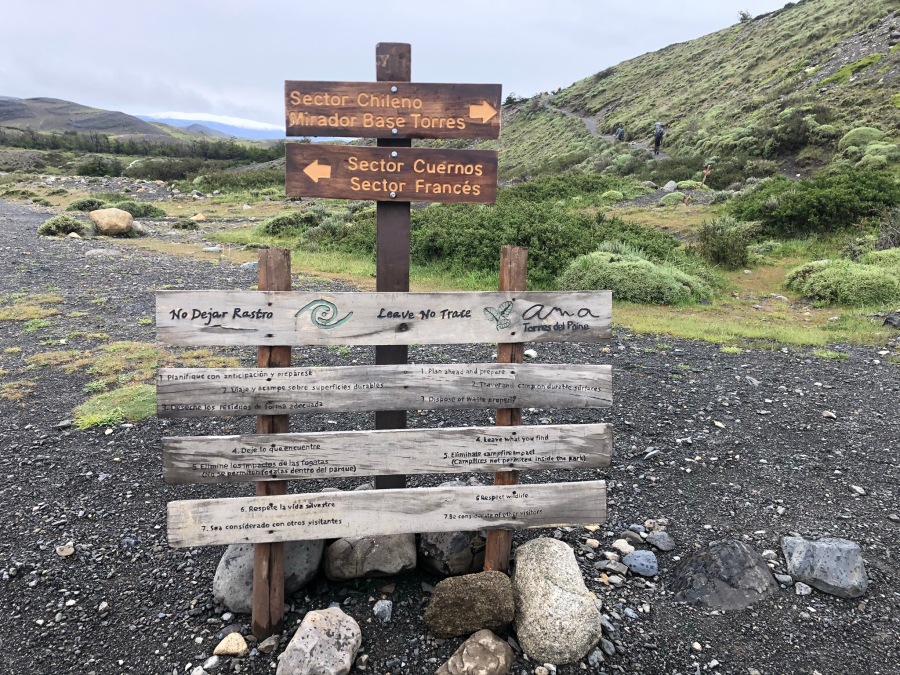
We found the guide adequate but could not recommend it by itself. But neither are we in position to recommend another guide. We supplemented the info from online websites such as Besthike.com, the El Chalten website and the AllTrails app. We found these sites in some cases to be more accurate, or have more comprehensive information, than the book. Our advice would be, shop around for another guide before buying this one.
As with the TMB we carried no actual map with us, relying on the guide, Maps are generally not needed for either of these treks, unless you plan on exploring off trail. An accurate one might have made a good supplement to the guide book.
